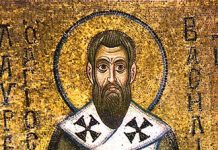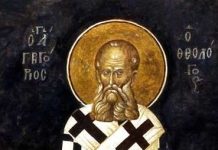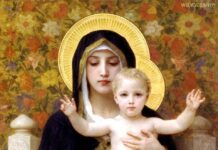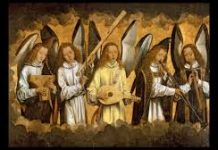On Monday February 22 we celebrate the Feast of the Chair of St Peter. What do we mean by the Chair of Peter and what significance does it have for the Papacy vis-a-vis the Church and the world at large?
Obviously when we are talking about the Chair of St Peter we are in no way referring to the ornamented chair on which the Pope sits, which is to be found just in the apse of St Peter’s Basilica. If that would be the case then the Feast of the Chair of St Peter can rightly risk bridging on the ridiculous. More than that, the Feast of the Chair of St Peter is one which makes us appreciate, respect and follow with great love, care and responsibility the spiritual authority which that Chair stands for in the person of the present Pope Francis.
The Chair of St Peter is technically known as Cathedra Petri in Latin. In St Peter’s Basilica it is to be detected in the back chamber, behind the well-known altar, on the farthest back wall, just below the prominent stained glass figure showing the Holy Spirit represented as a dove. Regarding the original chair, the Catholic Encyclopedia article has it that “the seat is about one foot ten inches above the ground, and two feet eleven and seven-eighths inches wide; the sides are two feet one and one-half inches deep; the height of the back up to the tympanum is three feet five and one-third inches; the entire height of the chair is four feet seven and one-eighth inches. According to the examination then made by Padre Garucci and Giovanni Battista de Rossi, the oldest portion is a perfectly plain oaken arm-chair with four legs connected by cross-bars. The wood is much worm-eaten, and pieces have been cut from various spots at different times, evidently for relics. To the right and left of the seat four strong iron rings, intended for carrying-poles, are set into the legs.”
Throughout the centuries there have been numerous changes effected to the chair to both mend and embellish it, and the same article from the Catholic Encyclopedia also observes that “during the Middle Ages it was customary to exhibit it yearly to the faithful; the newly-elected pope was also solemnly enthroned on this venerable chair, a custom that ceased at the transfer of the papal capital to Avignon in the early part of the fourteenth century”.
The symbolic importance of the Chair is so great that already in the seventeenth century it was felt that this treasured relic of the Cathedra Petri be conserved for future generations. It was Pope Alexander VII (1655-1567) who encased St Peter’s Chair above the apsidal altar of St Peter’s in an enormous bronze casing, designed by the famed Italian artist and architect Gianlorenzo Bernini (1598-1682), carried by four Doctors of the Church Ambrose, Augustine, Athanasius and Chrysostom.
All these four great Doctors of the Church had something to say on the importance of St Peter and the Church’s unity. St Ambrose of Milan, in his De Fide, says: [Christ] made answer: ‘You are Peter, and upon this rock will I build my Church. . . . ’ Could he not, then, strengthen the faith of the man to whom, acting on his own authority, he gave the kingdom, whom he called the rock, thereby declaring him to be the foundation of the Church [Matt. 16:18]? (The Faith 4:5 [A.D. 379]).
On his part, St Augustine says the same thing in his Letter 53: If the very order of episcopal succession is to be considered, how much more surely, truly, and safely do we number them [the bishops of Rome] from Peter himself, to whom, as to one representing the whole Church, the Lord said, ‘Upon this rock I will build my Church, and the gates of hell shall not conquer it.’ Peter was succeeded by Linus, Linus by Clement. … In this order of succession a Donatist bishop is not to be found (Letters 53:1:2 [A.D. 412]).
St Athanasius (362), the great defender of orthodoxy, said that Rome is called the Apostolic throne (Athanasius, Hist. Arian, ad Monach. n. 35) whereas he referred to Peter as The Chief, Peter (Athanasius, In Ps. xv. 8, tom. iii. p. 106, Migne).
Finally, St John Chrysostom writes: “[N]o human power can part what God has united. It is said of husband and wife: Wherefore a man shall leave father and mother and shall cling to his wife; and they shall be two in one flesh [Gen. II: 24.]: Therefore what God has joined together, let no man put asunder. [Matt. XIX: 6.] Thou canst not, O man, dissolve the nuptial tie: how hopest thou to divide the Church? . . . Believe me, O man, there is no power like the power of the Church. Cease thy battling, lest thou lose thy strength; wage not war with heaven. When it is with man thou warrest, thou mayst win or lose; but when thy fighting is against the Church, it is impossible that thou shouldst conquer, for God is above all strength. Do we provoke the Lord to jealousy? Are we stronger than he? [1 Cor. X: 22.] God founded, God gave firmness: who shall be so bold as to pull it down? . . . The Church is stronger than heaven itself: Heaven and earth shall pass, but my words shall not pass. [Matt. XXIV: 35.] What words? Thou art Peter; and upon this Rock will I build my Church, and the gates of hell shall not prevail against it. [Matt. XVI: 18.].
Undoubtedly, in the last pericope, the golden-mouthed John is referring directly to today’s gospel wherein in the sixteenth chapter of the Gospel of St Matthew, after Peter’s affirmation: You are the Christ, the Son of the living God (Matt 16:16), Jesus answered him: Blessed are you, Simon Bar-Jona! For flesh and blood has not revealed this to you, but my Father who is in heaven. And I tell you, you are Peter, and on this rock I will build my church, and the powers of death shall not prevail against it. I will give you the keys of the kingdom of heaven, and whatever you bind on earth shall be bound in heaven, and whatever you loose on earth shall be loosed in heaven (Matt 16:17-19).
The logical conclusion from St John Chrysostom’s commentary of this text is that [Peter is] the first of the Apostles, the foundation of the Church, the coryphaeus of the choir of disciples.
In his weekly catechesis of February 22, 2006, Pope Benedict XVI presents to us the spiritual significance of the feast of the Chair of St Peter. First he gives the historical context for the Feast. He said: Today, the Latin-rite liturgy celebrates the Feast of the Chair of St Peter. This is a very ancient tradition, proven to have existed in Rome since the fourth century. On it we give thanks to God for the mission he entrusted to the Apostle Peter and his Successors.
Then he moves on to explain the notion of Cathedra and magisterium. “Cathedra” literally means the established seat of the Bishop, placed in the mother church of a diocese which for this reason is known as a “cathedral”; it is the symbol of the Bishop’s authority and in particular, of his “magisterium”, that is, the evangelical teaching which, as a successor of the Apostles, he is called to safeguard and to transmit to the Christian Community...
But what is particular about the See of Rome? Continues Pope Benedict: From there [Antioch], Providence led Peter to Rome. Therefore, we have the journey from Jerusalem, the newly born Church, to Antioch, the first centre of the Church formed from pagans and also still united with the Church that came from the Jews. Then Peter went to Rome, the centre of the Empire, the symbol of the “Orbis” – the “Urbs”, which expresses “Orbis”, the earth, where he ended his race at the service of the Gospel with martyrdom. So it is that the See of Rome, which had received the greatest of honours, also has the honour that Christ entrusted to Peter of being at the service of all the particular Churches for the edification and unity of the entire People of God. The See of Rome, after St Peter’s travels, thus came to be recognized as the See of the Successor of Peter, and its Bishop’s “cathedra” represented the mission entrusted to him by Christ to tend his entire flock.
Hence, and as a conclusion which Pope Benedict gives in this catechesis entitled “On this rock I will build my Church”, celebrating the “Chair” of Peter, therefore, as we are doing today, means attributing a strong spiritual significance to it and recognizing it as a privileged sign of the love of God, the eternal Good Shepherd, who wanted to gather his whole Church and lead her on the path of salvation.
On Monday 22 February, 2016, in his Mass with members of the Roman Curia during the Extraordinary Jubilee of Mercy, while reminding us of the double mission of the Roman Pontiff to conserve the church’s unity and fidelity to the Gospel and compassionate care of God’s People, Pope Francis said in his homily: Let us allow grace to shape our hearts anew in order to believe, and to open our mouths in order to profess the faith and obtain salvation (cf. Rom 10:10). Thus, let us make our own the words of Peter: “You are the Christ, the Son of the living God” (Mt 16:16). May our thought and our gaze be fixed on Jesus Christ, the beginning and the end of all actions of the Church. He is the foundation and no one may lay a different one (cf. 1 Cor 3:11). He is the “rock” upon which we must build.
Christ, as St Pope Leo the Great said in one of his sermons, chose Peter to preside at the calling of all nations, and to be set over all the apostles and all the fathers of the Church. Though there are in God’s people many shepherds, Peter is thus appointed to rule in his own person those whom Christ also rules as the original ruler… Whatever Christ has willed to be shared in common by Peter and the other leaders of the Church, it is only through Peter that he has given to others what he has not refused to bestow on them.
O Father, we pray for our dear Pope Francis so that You may preserve him, give him life, make him blessed upon the earth and deliver him not up to the will of his enemies. May he, by his word and example, edify us, under his charge, in order that together with the flock entrusted to him, he attains eternal life. Through Christ our Lord. Amen.











